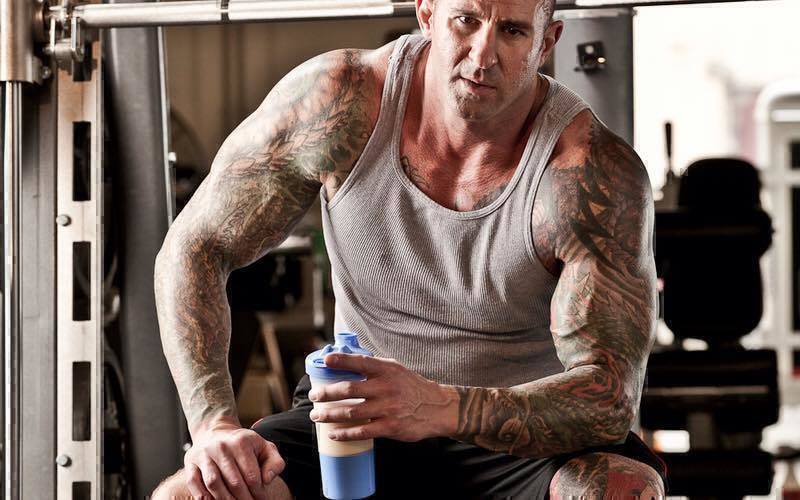SPONSORED
In past GI Jobs articles, I’ve covered both full-body training and supersets . Now, I’m going to more or less combine these two concepts with a popular technique I use often: circuit training.
Circuit training is a great method for anyone looking to get fit and lean through full-body training while also saving time. Come to think of it, if you’ve been in the military you’ve probably done circuit training before – but probably not quite like I design it.
The key feature of circuit training is that you can do up to 10 exercises consecutively, or even more, with literally no rest (except for the amount of time it takes you to move from one exercise to the next). This benefits two areas: (1) It keeps your metabolic rate high to maximize fat-burning, and (2) it keeps the heart rate elevated to enhance conditioning.
In other words, circuit training is basically weight-lifting combined with cardio. So if you’re someone who hates the thought of doing a separate cardio routine after lifting weights, consider incorporating circuit training you’re your routine. Below, I’ll show you how to do it.
Putting Together a Circuit
Designing your own circuit training workout is pretty simple: Choose one exercise per major muscle group, and do the exercises one after another without resting between exercises. After all exercises are complete, take a rest period of anywhere from 1-3 minutes, then repeat the circuit 2-4 more times (depending on your current fitness level).
When designing a circuit, I highly recommend choosing exercises that can be done in the same location; this will minimize downtime between exercises and keep the training pace high. When I put together individual circuit workouts, I’ll often pick one piece of equipment and do all exercises at that “station” – for example, an all-dumbbell circuit, an all-barbell circuit, all cables, all bodyweight exercises, etc. These “one-piece-of-equipment” circuits are on full display in my Circuit Maximus program on JimStoppani.com.
As for what muscle groups to choose exercises for and how to order them, here’s a body part/exercise order I use often for circuits:
- Chest
- Back
- Legs
- Shoulders
- Traps
- Calves
- Triceps
- Biceps
- Forearms
- Abs
As you can see, I training both large and small muscle groups for a total of 10 exercises per circuit. However, if you want to speed things along, you can probably get away with dropping a couple of the smaller body parts – namely, traps and forearms.
You also don’t have to train every major muscle group in every circuit, or even do full-body training every time. You can do an upper body-only circuit (chest, back, shoulders, biceps, triceps); a push-pull-legs circuit (chest, back, legs); or any number of combinations.
Sample Upper Body-Only Circuit
Dumbbell Bench Press x 10 reps
Dumbbell Bent-Over Row x 10 reps
Standing Overhead Dumbbell Press x 10 reps
Overhead Dumbbell Triceps Extension x 10 reps
Dumbbell Curl x 10 reps
Complete 3 rounds total
When to do Circuit Training
You have some options as to how often and when you do circuit training in your program, depending on what type of training split you follow. Here’s I’ll briefly discuss circuit training in terms of the three broad categories of splits I covered in my Split Decision article:
Full-Body Split: If you do nothing but full-body training, you can literally do circuit workouts 3-6 days per week. But keep in mind, circuit training and full-body training are not necessarily the same thing. As I mentioned above, you can do a circuit that doesn’t hit all muscle groups. You can also do full-body training, doing one exercise per bodypart, without technically doing a circuit; in this case, you’d do all sets of one exercise before moving onto the next. Most of the full-body workouts in my Train With Jim series, in fact, are not circuit training.
Upper Body/Lower Body Split: You can work circuits into an upper/lower split in a few different ways. One way is, you can do upper body-only and lower body-only circuits on their respective days. I gave an example of an upper body circuit above; a lower body circuit might look like this:
Lower Body-Only Circuit
Box Jumps x 6 reps
Goblet Squat x 12 reps
Dumbbell Romanian Deadlift x 12 reps
Leg Curl x 12 reps
Leg Extension x 12 reps
Complete 4 rounds total
Another way to utilize circuits in an upper/lower split is to add one full-body training day to your week. For example, do non-circuit workouts Monday-Thursday (upper body on Monday and Wednesday, lower body on Tuesday and Thursday), and then do a full-body circuit on Friday. The full-body day in this case could be considered an “active rest” day. My Lucky 13 Circuit routine on JimStoppani.com would work here.
Body Part Split: As like with the upper/lower split, circuits can be worked into a body part split routine by adding a full-body circuit day to the end of the week as “active rest.” For example, let’s say you follow a 5-day split where you train chest on Monday; back on Tuesday; legs (including calves) on Wednesday; arms and abs on Thursday; and shoulders and traps on Friday. You could add a full-body circuit workout on either Saturday or Sunday – like my 7 Station Shred circuit.
Short Circuit Your Program
The possibilities are endless when it comes to circuit training – that’s why I like it so much. For more specific circuit workouts, visit JimStoppani.com. I have a bunch there. Next time you’re in the mood for a full-body workout and are short on time, dial up a circuit!
READ NEXT: UNDERSTANDING MACRONUTRIENTS 101






